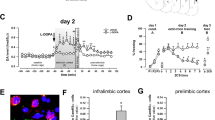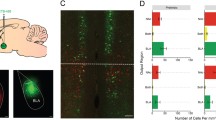Abstract
This research examined the roles played by the ventromedial orbital prefrontal cortex (OPFC) and the infralimbic/prelimbic prefrontal cortex (I/P PFC) during discriminative fear conditioning. The first experiment included nine rats with bilateral lesions to the I/P PFC, an additional nine with OPFC lesions, and eight sham lesion controls. Behavioural analysis was conducted using a discriminative fear conditioning to context task 10 days after surgery. Results indicate that lesions to ventromedial orbital prefrontal cortex result in generalized fear and impaired extinction. In contrast, infralimbic/prelimbic cortical lesioned animals exhibit appropriate fear response patterns and extinction, but show a specific impairment in spontaneous recovery. To ascertain why I/P PFC lesion rats did not exhibit spontaneous recovery, a second experiment was conducted. All procedures in the second experiment were identical to the first except a decay period was employed in place of extinction training. Results from the second experiment indicate that the difficulty retrieving the extinguished association is related to extinction processes and not decay. Taken together, these findings suggest that OPFC and I/P PFC have distinct roles in associative processes necessary for discriminative fear conditioning, extinction, and spontaneous recovery. These results further implicate OPFC and I/P PFC in the pathology underlying generalized anxiety disorder.








Similar content being viewed by others
References
Amaral DG (2003) The amygdala, social behavior, and danger detection. Ann N Y Acad Sci 1000:337–347
Amundson JC, Miller RR (2008) CS-US temporal relations in blocking. Learn Behav 36:92–103
Antoniadis EA, McDonald RJ (1999) Discriminative fear conditioning to context expressed by multiple measures of fear in the rat. Behav Brain Res 101:1–13
Antoniadis EA, McDonald RJ (2000) Amygdala, hippocampus, and discriminative fear conditioning to context. Behav Brain Res 108:1–19
Antoniadis EA, McDonald RJ (2001) Amygdala, hippocampus, and unconditioned fear. Exp Brain Res 138:200–209
Antoniadis EA, McDonald RJ (2006) Fornix, medial prefrontal cortex, nucleus accumbens and mediodorsal thalamic nucleus: roles in fear context discrimination. Neurobiol Learn Mem 85:71–85
Baas JMP, van Ooijen L, Gourdriaan A, Kenemans JL (2008) Failure to condition to a cue is associated with sustained contextual fear. Acta Psychol 127:581–592
Bechara A, Damasio H, Damasio AR, Lee GP (1999) Different contributions of the human amygdala and ventromedial prefrontal cortex to decision-making. J Neurosci 19:5473–5481
Bouton ME (1993) Context, time, and memory retrieval in the interference paradigms of Pavlovian learning. Psychol Bull 114:80–99
Brandon SE, Bombace JC, Falls WA, Wagner AR (1991) Modulation of unconditioned defence reflexes by a putative emotive Pavlovian conditioned stimulus. J Exp Psychol Anim Behav Process 17:312–322
Bruchey AK, Shumake J, Gonzalez-Lima G (2007) Network model of fear extinction and renewal functional pathways. Neuroscience 145:423–437
den Ouden HE, Friston KJ, Daw ND, McIntosh AR, Stephan KE (2009) A dual role for prediction error in associative learning. Cereb Cortex 19:1175–1185
Fogel SM, Smith CT, Beninger RJ (2009) Evidence for 2-stage models of sleep and memory: learning-dependent changes in spindles and theta in rats. Brain Res Bull 79:445–451
Grillon C (2002) Startle reactivity and anxiety disorders: aversive conditioning, context, and neurobiology. Biol Psychiatry 52:958–975
Hariri AR, Mattay VS, Tessitore A, Kolachana B, Fera F, Goldman D, Egan MF, Weinberger DR (2002) Serotonin transporter genetic variation and the response of the amygdala. Science 297:400–403
Hoover WB, Vertes RP (2007) Anatomical analysis of afferent projection to the medial prefrontal cortex in the rat. Brain Struct Funct 212:149–179
Jay TM, Witter MP (1991) Distribution of hippocampal CA1 and subicular efferents in the prefrontal cortex of the rat studied by means of anterograde transport of Phaseolus vulgaris-leucoagglutinin. Comp Neurol 313:574–586
Johnson AW, Gallagher M, Holland PC (2009) The basolateral amygdala is critical to the expression of pavlovian and instrumental outcome specific reinforcer devaluation effects. Neuroscience 29:696–704
Koch K, Schachzabel C, Wagner G, Reichenbach JR, Sauer H, Schlosser R (2008) The neural correlates of reward-related trial-and-error learning: an fMRI study with a probabilistic learning task. Learn Mem 15:728–732
Ledoux JE, Muller J (1997) Emotional memory and psychopathology. Phil Trans R Soc Lond B Biol Sci 352:1719–1726
Lissek S, Powers AS, McClure EB, Phelps EA, Woldehawariat G, Grillon C, Pine DS (2005) Classical fear conditioning in the anxiety disorders: a meta-analysis. Behav Res Ther 43:1391–1424
Maren S (2008) Pavlovian fear conditioning as a behavioural assay for hippocampus and amygdala function: cautions and caveats. Behav Neurosci 28:1661–1666
McDonald RJ, King AL, Hong NS (2001) Context-specific interference on reversal learning of a stimulus-response habit. Behav Brain Res 121:149–165
McNally RJ (2007) Mechanisms of exposure therapy: how neuroscience can improve psychological treatments for anxiety disorders. Clin Psychol Rev 27:750–759
Mennin DS, Heimberg RG, Turk CL, Fresco DM (2005) Preliminary evidence for an emotion dysregulation model of generalized anxiety disorder. Behav Res Therapy 43:1281–1310
Milad MR, Quirk GJ (2002) Neurons in medial prefrontal cortex signal memory for fear extinction. Nature 420:70–74
Milad MR, Rauch SL (2007) The role of the orbitofrontal cortex in anxiety disorders. Ann N Y Acad Sci 1121:546–561
Millan MJ (2003) The neurobiology and control of anxious states. Progr Neurobiol 70:83–244
Morgan M, LeDoux JE (1999) Contribution of ventrolateral prefrontal cortex to the acquisition and extinction of conditioned fear in rats. Neurobiol Learn Mem 72:244–251
Nutt DJ, Ballenger JC, Sheehan D, Wittchen H (2002) Generalized anxiety disorder: comorbidity, comparative biology and treatment. Int J Neuropsychopharmacol 5:315–325
Oler JA, Ramos RL, Penley SC, Markus EJ (2005) Hippocampal and amygdalar involvement in discriminatory place learning. Neuroscience 132:1–12
Ostlund SB, Balleine BW (2007) The contribution of orbitofrontal cortex to action selection. Ann N Y Acad Sci 1121:174–192
Parvez K, Rosenegger D, Orr M, Martens K, Lukowiak K (2006) Canadian association of neurosciences review: learning at a snail’s pace. Can J Neurol Sci 33:347–356
Phelps EA, Delgado MR, Nearing KI, LeDoux JE (2004) Extinction learning in humans: role of amygdala and vmPFC. Neuron 16:895–905
Quirk GJ, Gehlert DR (2003) Inhibition of the amygdala: key to pathological states? Ann N Y Acad Sci 985:263–272
Quirk GJ, Russo GK, Barron JL, Lebron K (2000) The role of ventromedial prefrontal cortex in the recovery of extinguished fear. Neuroscience 20:6225–6231
Quirk GJ, Likhtik E, Pelletier JG, Pare D (2003) Stimulation of medial prefrontal cortex decreases the responsiveness of central amygdala output neurons. Neuroscience 23:8800–8807
Rajah MN, Ames B, D’Esposito M (2008) Prefrontal contributions to domain-general executive control processes during temporal context retrieval. Neuropsychologia 26:1088–1103
Rau V, Fanselow SM (2009) Exposure to a stressor produces a long lasting enhancement of fear learning in rats. Stress 12:125–133
Reimer AE, Oliveira AR, Brandao ML (2008) Selective involvement of GABAergic mechanisms of the dorsal periaqueductal gray and inferior colliculus on the memory of the contextual fear as assessed by the fear potentiated startle test. Brain Res Bull 76:545–550
Roberts NA, Beer JS, Werner KH, Scabini D, Levens SM, Knight RT, Levenson RW (2004) The impact of orbital prefrontal cortex damage on emotional activation to unanticipated and anticipated acoustic startle stimuli. Cogn Affect Behav Neurosci 4:307–316
Rudy JW, Huff NC, Matus-Amut P (2004) Understanding contextual fear conditioning: insights from a two-process model. Neurosci Biobehav Rev 25:675–685
Rudy JW, Biedenkapp JC, O’Reilly RC (2005) Prefrontal cortex and the organization of recent and remote memories: an alternative view. Learn Memory 12:445–446
Schoenbaum G, Saddoris MP, Stalnaker TA (2007) Reconciling the roles of orbitofrontal cortex in reversal learning and the encoding of outcome expectancies. Ann N Y Acad Sci 1121:320–335
Surget A, Belzung C (2008) Involvement of vasopressin in affective disorders. Eur J Pharmacol 583:340–349
Tait DS, Brown VJ (2007) Difficulty overcoming learned non-reward during reversal learning in rats with ibotenic acid lesions of orbital prefrontal cortex. Ann N Y Acad Sci 1121:407–420
Tait DS, Marston HM, Shahid M, Brown VJ (2009) Asenapine restores cognitive flexibility in rats with medial prefrontal cortex lesions. Psychopharmacology 202:295–306
Wagner MJ, Smith MA (2008) Shared internal models for feedforward and feedback control. Neuroscience 28:10663–10673
Walker DL, Toufexis DJ, Davis M (2003) Role of the bed nucleus of the stria terminalis versus the amygdala in fear, stress, and anxiety. Eur J Pharmacol 463:199–216
Acknowledgments
RJM is currently a Canada Research Chair. This research was supported by a grant awarded to RJM from the Natural Sciences and Engineering Research Council agency.
Author information
Authors and Affiliations
Corresponding author
Rights and permissions
About this article
Cite this article
Zelinski, E.L., Hong, N.S., Tyndall, A.V. et al. Prefrontal cortical contributions during discriminative fear conditioning, extinction, and spontaneous recovery in rats. Exp Brain Res 203, 285–297 (2010). https://doi.org/10.1007/s00221-010-2228-0
Received:
Accepted:
Published:
Issue Date:
DOI: https://doi.org/10.1007/s00221-010-2228-0




